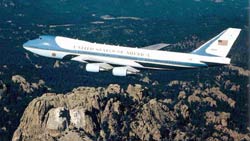|
|
The
Arrogance of Power - A Presidential Visit
October 1999 Commentary by Rick Francona
The Presidential visit to Syria was greeted by the Syrian people and government alike with great enthusiasm. Whether or not they agree with U.S. policy in the region, most Syrians like the United States, what it stands for, and the American people. The Syrian government was happy because the visit of a sitting U.S. President lends great legitimacy to the regime of Hafiz Al-Asad. Asad further took pride in the fact that Clinton was coming to Damascus to consult with him, rather than him going to Washington to meet Clinton. Immediately after the announcement of the impending visit, a team of security and logistics personnel descended on Damascus, overwhelming the small U.S. Embassy, where less than 30 foreign service and military personnel are assigned. The main members of this team were the White House liaison officers, White House Communications Agency technicians, the Secret Service and the Air Force One advance teams. Let's look at the actions of the Air Force One team as an example. As most people know, Air Force One refers to the Presidential aircraft. (It is the actually the callsign used by any Air Force aircraft while the President is on board. The current primary Air Force One fleet is made up of two specially configured Boeing 747's. They are well-appointed, beautifully maintained, and are the pride of the USAF 89th Airlift Wing, located at Andrews Air Force Base, Maryland. Two USAF officers from the White House Presidential Pilot's Office arrived in Syria about a week before the day of the scheduled six-hour visit. Since the visit would not involve an overnight stay, security of the aircraft overnight was not an issue. The officers wanted to look at the airport, talk to Syrian security and protocol officials, and ensure that any special aircraft needs could be accommodated. Since Syrian Arab Airlines operates two Boeing 747's, they were familiar with the dimensions and ramp requirements for the jumbo jet. The problems started with the demands placed on the Syrians. The young officers demanded that they be allowed to inspect the airport fire department to determine if it was adequate. However, the arrogance with which they made the demand immediately put the Syrians on the defensive. The Syrian fire chief asked the officers (both fighter pilots) how much fire fighting experience they had and what made them qualified to inspect the airport equipment. Then, they demanded to inspect the runway, a runway that was used everyday to handle commercial airliners and military transports, including Boeing 747's. After these embarrassing demands, the officers then asked to review the protocol arrangements for the aircraft, such as where it would be positioned for the arrival and departure, how the steps would be handled, reviewing stand positions, etc. The Syrian palace protocol officers, who handle visits of foreign heads of state on a weekly basis, explained the procedure that President Asad-the host-preferred. The officers flatly rejected the Syrian procedure, claiming that the aircraft had to be positioned in a certain way, and that failure to accede to their demands would result in the cancellation of the visit. After all, they declared, the U.S. President was "the leader of the free world." The Syrians reiterated their procedures, explaining calmly that this was Syria. In the end, the Syrian procedures prevailed. On the day of the visit, the USAF officers and Secret Service officers demanded access to the control tower to monitor Syrian air traffic control procedures to ensure the safety of Air Force One. Again, the Syrians were a bit insulted by the insinuation that their procedures were not up to standards. The Syrians acceded to the demand, but asked if President Asad was visiting the United States and arrived at Andrews Air Force Base, would they be allowed to inspect the fire department and runways, and review American air traffic control procedures? The USAF officers were typical of the advance teams. On the Secret Service side, the debate with the Syrians revolved around the use of the cars to transport the two Presidents from the airport. The Syrians, as hosts, insisted that President Clinton ride in Asad's car. The Secret Service refused to allow the American President, again referred to as "the leader of the free world," to ride in any other car than the specially-built limousine (one of eight vehicles flown in by USAF transport aircraft). This was not resolved until the last minute, with a compromise that Asad would ride in Clinton's car, but the car would have Syrian license plates. The visit happened, but left
a negative impression of Americans among all the Syrian officials that
were involved. Many remarked to embassy officers that they were happy to
host the U.S. President, and although they realize that Syria is a third
world country, they did not like being reminded of it and treated like
it. They resented the arrogance of power.
|
 Senior
American officials traveling abroad present an image to foreign governments
and populations. The perceptions that the visitors create during these
visits may or may not be positive. This is an anecdotal account of one
such visit - the six-hour visit of President Bill Clinton to Damascus,
Syria in late 1994. Although we are now in the President's second term,
little has changed in the way his staff handles foreign visits.
Senior
American officials traveling abroad present an image to foreign governments
and populations. The perceptions that the visitors create during these
visits may or may not be positive. This is an anecdotal account of one
such visit - the six-hour visit of President Bill Clinton to Damascus,
Syria in late 1994. Although we are now in the President's second term,
little has changed in the way his staff handles foreign visits.